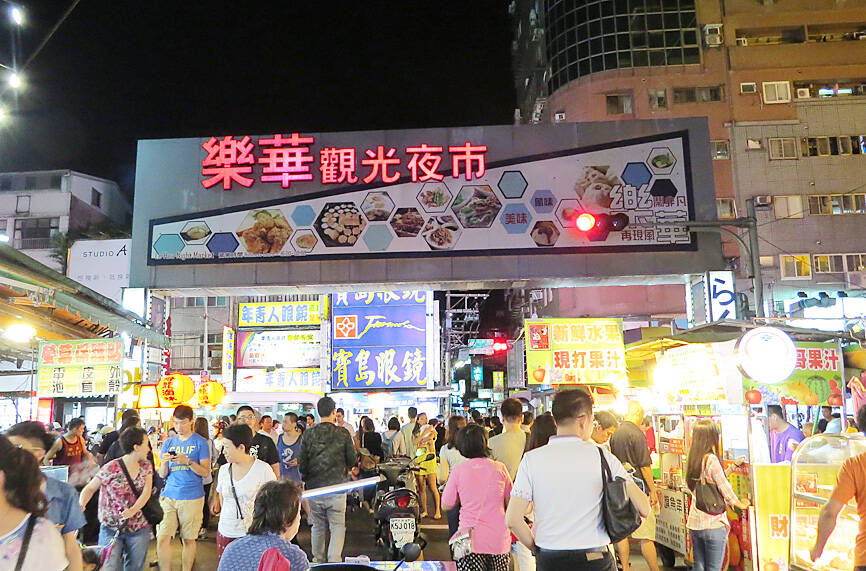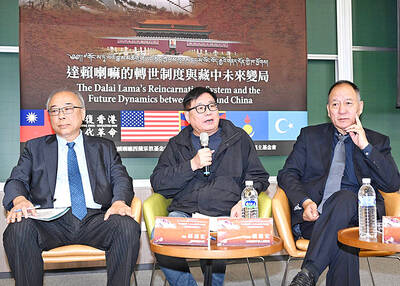The nation’s top six nighttime economy hot spots are in New Taipei City, with Yonghe District (永和) at No. 1, followed by Banciao (板橋), Lujhou (蘆洲), Sanchong (三重), Jhonghe (中和) and Sinjhuang (新莊) districts, Ministry of the Interior data show.
Telecommunications and demographic data show that the number of people in these districts at night exceeds that of the areas during the day or the number of people registered to households there, the ministry said.
The ministry’s new “telecom signaling demographic data” combines information collected from mobile base stations with socioeconomic spatial data from shopping areas, bus stations, healthcare facilities and convenience stores.

Photo: Lai Hsiao-tung, Taipei Times
It can be used to study the retail or nighttime economy, and can help inform policy decisions regarding medical and transportation needs, personnel assignments, disease prevention, fire control and housing, the ministry said.
People flow means business opportunities, and aside from regional factors, people flow at different times of the day can have different meanings, it said.
Its “nighttime economy potential hot spot map” was created by weighting factors, including the number of people in areas during certain times, the density of people staying during the night and population inflow, it said.
Rounding out the top 10 districts or townships with the highest nighttime economy index number, after the six in New Taipei City, are Kaohsiung’s Fongshan District (鳳山), Taoyuan’s Taoyuan District (桃園) and Taichung’s South (南區) and North (北區) districts.
The telecom signaling demographic data can also be used to create a medical resource demand map, the ministry said.
For example, the data show that, aside from areas in the mountains, northern Taiwan has more medical resource demand than the rest of the nation, and accounting for the number of people in areas at night, Taipei’s Daan (大安) and Zhongzheng (中正) districts, along with Yonghe, have the greatest medical resource demand, it said.
The data can also be used to create a high population density disease infection risk index of districts, villages and boroughs, and can monitor shopping areas, traditional markets and night markets to help authorities warn or evacuate people from an area, or to inform vaccine distribution plans, it said.

ALIGNED THINKING: Taiwan and Japan have a mutual interest in trade, culture and engineering, and can work together for stability, Cho Jung-tai said Taiwan and Japan are two like-minded countries willing to work together to form a “safety barrier” in the Indo-Pacific region, Premier Cho Jung-tai (卓榮泰) yesterday said at the opening ceremony of the 35th Taiwan-Japan Modern Engineering and Technology Symposium in Taipei. Taiwan and Japan are close geographically and closer emotionally, he added. Citing the overflowing of a barrier lake in the Mataian River (馬太鞍溪) in September, Cho said the submersible water level sensors given by Japan during the disaster helped Taiwan monitor the lake’s water levels more accurately. Japan also provided a lot of vaccines early in the outbreak of the COVID-19 pandemic,

Kaohsiung Mayor Chen Chi-mai (陳其邁) on Monday announced light shows and themed traffic lights to welcome fans of South Korean pop group Twice to the port city. The group is to play Kaohsiung on Saturday as part of its “This Is For” world tour. It would be the group’s first performance in Taiwan since its debut 10 years ago. The all-female group consists of five South Koreans, three Japanese and Tainan’s Chou Tzu-yu (周子瑜), the first Taiwan-born and raised member of a South Korean girl group. To promote the group’s arrival, the city has been holding a series of events, including a pop-up

TEMPORAL/SPIRITUAL: Beijing’s claim that the next Buddhist leader must come from China is a heavy-handed political maneuver that will fall flat-faced, experts said China’s requirement that the Dalai Lama’s reincarnation to be born in China and approved by Beijing has drawn criticism, with experts at a forum in Taipei yesterday saying that if Beijing were to put forth its own Dalai Lama, the person would not be recognized by the Tibetan Buddhist community. The experts made a remarks at the two-day forum hosted by the Tibet Religious Foundation of His Holiness the Dalai Lama titled: “The Snow Land Forum: Finding Common Ground on Tibet.” China says it has the right to determine the Dalai Lama’s reincarnation, as it claims sovereignty over Tibet since ancient times,

Temperatures in some parts of Taiwan are expected to fall sharply to lows of 15°C later this week as seasonal northeasterly winds strengthen, the Central Weather Administration (CWA) said today. It is to be the strongest cold wave to affect northern Taiwan this autumn, while Chiayi County in the southwest and some parts of central Taiwan are likely to also see lower temperatures due to radiational cooling, which occurs under conditions of clear skies, light winds and dry weather, the CWA said. Across Taiwan, temperatures are to fall gradually this week, dropping to 15°C to 16°C in the early hours of Wednesday